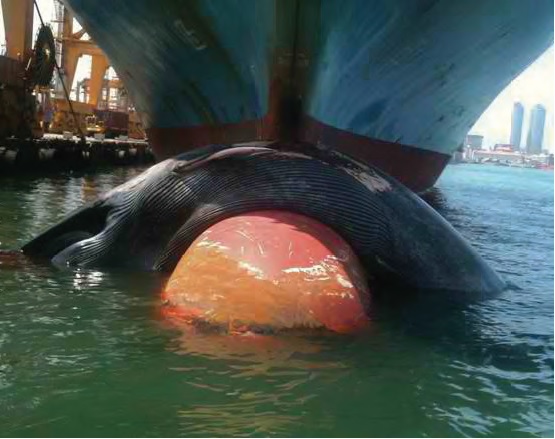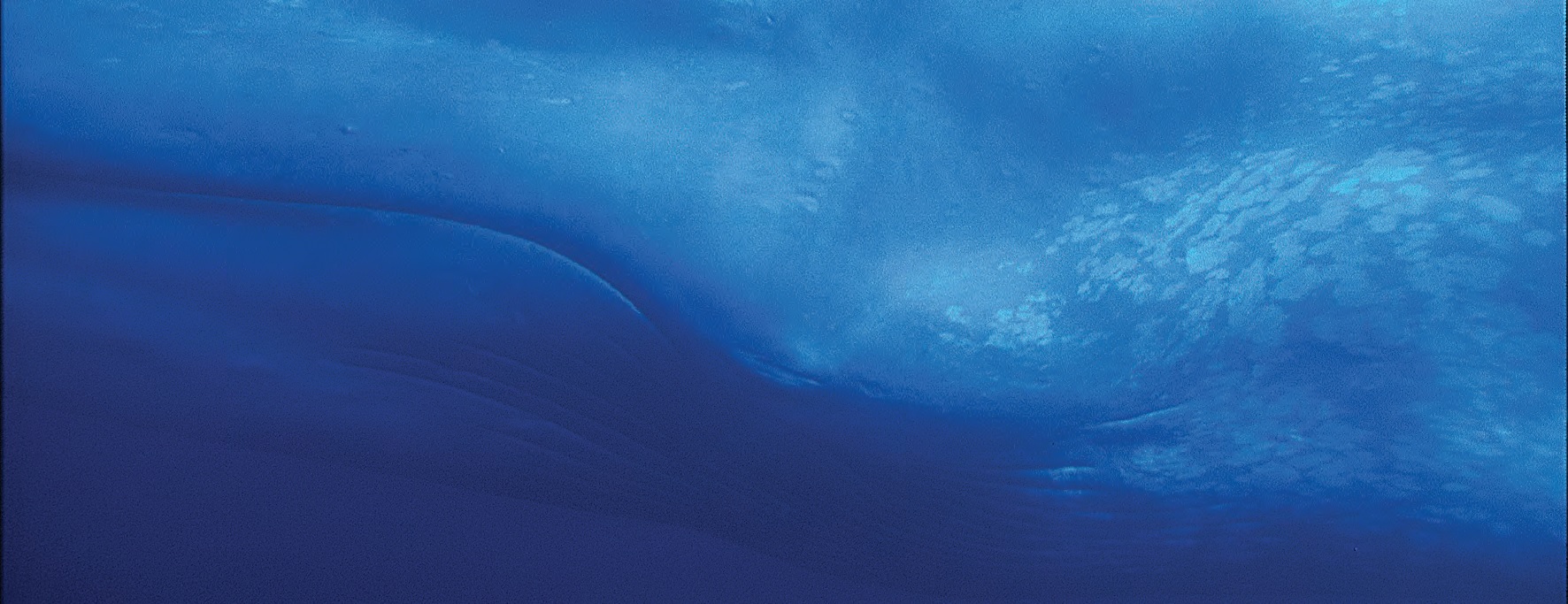Every year, about 300 whales feeding near the southern coast of Sri Lanka are hit more than a thousand times by large carriers up to 300 meters long. About 50 of these collisions are likely to be lethal for the rare Pygmy Blue Whales indigenous to Sri Lanka waters. Next year could likely be the “Year of No Return” of the Pygmy Blue Whales in the area, unless the Sri Lankan authorities, in collaboration with the World Shipping Council agree to submit a proposal to the International Maritime Organization (IMO) to shift the current lanes 15 nautical miles south, before the 27th of November deadline. Proposals submitted after this deadline would be enforced 24 months later.

Pygmy Blue Whale in Colombo harbour, draped on the bow of a container ship.
PHOTO CREDIT: SOPAKA KARUNASUNDARA
Friends of the Sea (FOS), an international NGO, urged the Sri Lankan Government, the World Shipping Council, and the world’s top ten shipping companies (NYK, Maersk, Evergreen Marine Corporation, CMA-CGM, MSC, Hapag-Lloyd, APL, Cosco, Hanjin, and CSCL) to submit the proposal to the International Maritime Organization (IMO) in an effort to stop the deadly strikes on the whales. FOS offered help to coordinate the meeting for the parties to discuss and prepare the proposal.
Paolo Bray, former European Director of the Dolphin-Safe Tuna project of the Earth Island Institute, is the founder and director of FOS. The Dolphin-Safe Tuna project saved millions of dolphins from mortality companies from 50 countries have products certified by FOS, and these companies have relied on FOS to assess the sustainability of their seafood origins. FOS certification requirements are benchmarked as being among the most strict. In addition, independent certification bodies perform external audits.
Over the years, FOS has expanded the scope of its audits and its seal of approval towards Sustainable Whale Watching Operators, Sustainable Shipping, and Sustainable Ornamental Fish. In the past, FOS had contributed to select conservation projects for the protection of albatross, whale sharks, monk seals and dolphins. Currently, FOS is involved in whale protection in Sri Lanka to prevent container ships from striking the Pigmy Blue Whales and other whales.
“The shipping industry has greatly reduced its environmental impact over the years,” explains Paolo Bray. “It is now time to deal with its silent impact on whales which are being decimated by ship strikes. Shifting the lanes 15 nautical miles south would reduce whale strikes by over 90%.”
Asha de Vos, a marine biologist at University of California, Santa Cruz, and founder of the Sri Lankan Blue Whale Project, described the Sri Lankan Pygmy Blue Whale in the New Scientist magazine last year, as a subspecie of the Atlantic blue whale (Balaenoptera musculus). The Pygmy Blue Whale has about a 24-meter length (79 ft), or 4 meters shorter than the 28-meter (92 ft) Antarctic blue whale subspecie (Balaenoptera musculus ssp. Intermedia); or 6 meters shorter than the 30-meters (98 ft) Atlantic blue whale parent. The Arkive.org says the parent Blue Whale just may be the largest and heaviest animal on earth, bigger than the largest dinosaurs; about the same size as a Boeing 737.

A 24-meter long Pygmy Blue Whale
PHOTO CREDIT: CURT JENNER CENTER FOR WHALE RESEARCH, WESTERN AUSTRALIA.
The Pygmy Blue Whale differs from the other blue whales in a number of physical characteristics. It has broader and shorter baleen plates, a shorter tail, a proportionately longer body in front of the dorsal fin, and a larger head relative to body size. The shorter tail is what gives the Pygmy Blue Whale the tadpole-like shape that results in differences in diving. In the Atlantic and Antarctic ‘true’ blue whales, there is a delay between the submergence of the dorsal fin and the caudal peduncle. In Pygmy Blue Whales, the dorsal and peduncle submerge simultaneously. Pygmy Blue Whales also tend to be darker than the other blue whales, and the shape of their blowhole is different.
Dr. Hidehiro Kato of Japan’s Fisheries Research Agency told BBC News Online in 2007 that “The ‘true’ blue is torpedo-shaped, but the Pygmy looks more like a tadpole, with a relatively big head and short tail. Their behaviour is different too. The Pygmies we’ve studied breed in the Indian and South Atlantic oceans and go south to the Antarctic to feed. But they don’t often go much further than 55 degrees South, while the ‘true’ blues go right up to the edge of the pack ice.” Unlike other blue whales, the Pygmy Blue Whales don’t migrate to the poles to feed.
The Centre for Whale Research in Western Australia reported in January 2014 that an Antarctic blue whale and a Pygmy Blue Whale were encountered feeding in the Sub-Tropical Convergence, adding a new piece to the puzzle regarding their movements around the Indian and Southern Oceans.
Despite the large size of these marine mammals, they only consume small shrimp-like krill through their baleen plates. Krills are between 0.4 and 6 inches in length, but most are less than 1 inch long. The baleen plates are the comb-like fibrous plates hanging from the upper jaw that are used to sieve food from seawater. As the whale’s mouth closes, water is expelled through the baleen plates, which trap the food on the inside to be swallowed.
The Pygmy Blue Whale was once confused for a small blue whale. However in 1966, observations of the whale led to a new subspecies and description based on differing characteristics between these marine mammals and their larger blue whale relatives. Thus, the Pygmy Blue Whale was given the scientific sub-specie name of Balaenoptera musculus ssp. Brevicauda, being shorter than both the Atlantic and the Antarctic blue whale.
In 1859, the Pygmy Blue Whales found in the northern Indian Ocean were assigned the name Balaenoptera ssp. Indica. However, in 1966, they were found to be no different than the Balaenoptera Brevicauda Pygmy Blue Whales in the south, except that their breeding seasons were six months apart.
The Pygmy Blue Whale also speaks a very different dialect. They are known for making loud majestic whale songs that appear to be performed only by the male whales. Pygmy Blue Whales off the coast of Sri Lanka have been repeatedly recorded making “songs” of four notes, lasting about two minutes each. While the exact meaning for these sounds is mostly unknown, it is assumed that these calls are used to locate potential mating partners.
While the Pygmy Blue Whales primarily give birth to a single offspring, they may also give birth to twins on rare instances.
Nowhere else have the Pygmy Blue Whales been observed so close to land. This makes Sri Lanka an ideal spot for scientists, marine biologists, and nature lovers who study blue whales. However, as Asha de Vos stated, “nearly 1,300 were killed by illegal Russian whaling in the 1960s and ’70s, but today the biggest threat is ship traffic, which is projected to double globally in the next 20 years.”
In more recent years, common threats for many species of whale include water pollution from oil spills, garbage and other human factors, noise pollution from loud jet engines, explosives, boating equipment, and over fishing which can affect whales living in highly competitive fishing environments.
On the proposed solution to shift the current shipping lanes 15 nautical miles south, Paolo Bray stated, “The artisanal fisheries and the whale-watching industry that are driving tourism in the area would also benefit. Coastal pollution would be reduced. Ships would, in the end, have to add only an average of 5 miles to their trips.” Bray believes, “By meeting the 27th of November deadline, Sri Lanka could become an example to be followed globally in environmental protection and whale conservation.”
